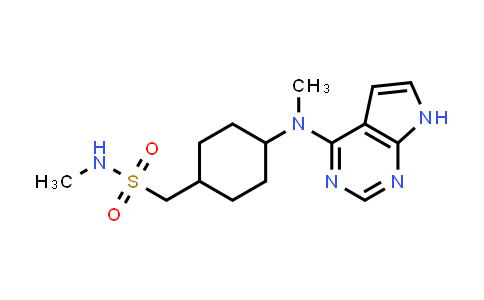| Chemical Name |
Oclacitinib |
| CAS Number |
1208319-26-9 |
| Molecular Formula |
C15H23N5O2S |
| Molecular Weight |
337.44 |
| Synonyms |
PF-03394197 |
Introduction of 1208319-26-9 :
Oclacitinib is a novel JAK inhibitor. Oclacitinib is most potent at inhibiting JAK1 (IC50=10 nM). IC50 & Target: IC50: 10 nM (JAK1), 18 nM (JAK2), 99 nM (JAK3), 84 nM (TYK2)[1] In Vitro: Using isolated enzyme systems and in vitro human or canine cell models, potency and selectivity of Oclacitinib is determined against JAK family members and cytokines that trigger JAK activation in cells. Inhibitory activity of Oclacitinib against JAK family members is determined in isolated enzyme systems. Oclacitinib inhibits JAK1, JAK2, JAK3, and TYK2 by 50% at concentrations (IC50's) of 10, 18, 99, and 84 nM, respectively. Oclacitinib is most potent against the JAK1 enzyme, showing a 1.8-fold selectivity for JAK1 vs. JAK2 and 9.9-fold selectivity toward JAK1 vs. JAK3. Oclacitinib inhibits JAK family members by 50% at concentrations (IC50's) ranging from 10 to 99 nM and does not inhibit a panel of 38 non-JAK kinases (IC50's > 1000 nM). Oclacitinib also inhibits the function of JAK1-dependent cytokines involved in allergy and inflammation (IL-2, IL-4, IL-6, and IL-13) as well as pruritus (IL-31) at IC50's ranging from 36 to 249 nM. Oclacitinib has minimal effects on cytokines that does not activate the JAK1 enzyme in cells (erythropoietin, granulocyte/macrophage colony-stimulating factor, IL-12, IL-23; IC50's > 1000 nM) [1].Topical treatment with Tofacitinib (0.1%) and Oclacitinib (0.1%) leads to significant reduction of cell migration from mouse ear explants compared with vehicle-treated ears (all P < 0.05). The cell counts of MHC class II positive cells (that is, Langerhans cells) are significantly lower in vehicle-treated compared with each JAK inhibitor–treated epidermis (all P < 0.01) [2]. In Vivo: Scratching bouts at the high dose in the Oclacitinib group are significantly less than in the vehicle-only group (P<0.01)[2]. Client-owned dogs (n=436) with moderate to severe owner-assessed pruritus and a presumptive diagnosis of allergic dermatitis are enrolled. Dogs are randomized to either Oclacitinib at 0.4-0.6 mg/kg orally twice daily or an excipient-matched placebo. An enhanced 10 cm visual analog scale (VAS) is used to assess the severity of pruritus from day 0 to 7 and to assess the severity of dermatitis on days 0 and 7. Dogs can remain on the study for 28 days. Oclacitinib produces a rapid onset of efficacy within 24 h[3].
| Purity |
NLT 98% |
| Storage |
at 20ºC 2 years |
*The above information is for reference only.
